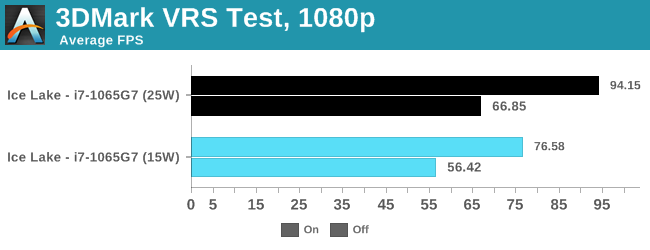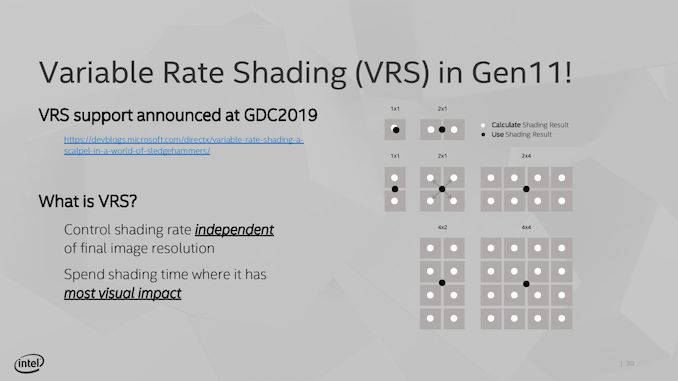The Ice Lake Benchmark Preview: Inside Intel's 10nm
by Dr. Ian Cutress on August 1, 2019 9:00 AM EST- Posted in
- CPUs
- Intel
- GPUs
- 10nm
- Core
- Ice Lake
- Cannon Lake
- Sunny Cove
- 10th Gen Core
Gaming Results (15W and 25W)
One of the biggest changes to the Ice Lake design is in the integrated graphics – Intel is now giving more focus and more die area to graphics, something it has arguably been neglecting for several years now. With Ice Lake, we move to a Gen11 graphics architecture, which is almost like the previous Gen9.5 but now with added support for variable rate shading (VRS), moving from 24 EUs to 64 EUs, and memory support up from LPDDR3-2133 to LPDDR4X-3733.


World of Tanks is a very CPU driven benchmark, and having the extra frequency of the 25W processor does help here. We're getting a sizeable uplift from Whiskey Lake, due to the extra EUs and memory frequency.


Our Final Fantasy test seemed to regress in 25W mode, although still within the noise. This test is still GPU bound, so adding the extra TDP to the CPU didn't actually help much. However, comparing to the Whiskey Lake integrated graphics, we've got over a 2x speedup.


Similarly with Civilization, with what is normally our 'IGP' settings, we are still GPU limited here.
One of Intel's newest features is Variable Rate Shading.
If developers add the option, soon to be an easy checkbox in Unity and Unreal, the game can decide to control the rate at which it shades pixels, from calculating every pixel down using one result across a 4x4 grid, to save compute power. Currently the only way to test this is with the 3DMark functional demo.

The new VRS test in 3DMark is designed as a feature test to show the potential uplift effect from enabling variable rate shading within a game. In both 15W and 25W modes, the data saw a good uplift, and we seemed to get more out of the 25W mode than the 15W mode.














261 Comments
View All Comments
jospoortvliet - Friday, August 2, 2019 - link
Sometimes people have insightful additions or questions. That is never you so I wouldn’t miss your ‘input’.Phynaz - Friday, August 2, 2019 - link
But yet you replied. Doh!Korguz - Friday, August 2, 2019 - link
and so did you !!! :-)Phynaz - Saturday, August 3, 2019 - link
Your comprehension skills aren’t that great, are they. Maybe that’s why you can’t afford a good cpu. Did you finish school?Korguz - Saturday, August 3, 2019 - link
yep.. but you obliviously havent as only children resort to insults, like you do. and again.. grow upPOlaris1983 - Thursday, August 1, 2019 - link
Thermals and TDP are a test for UNdervolting and OCing on THICC laptops using ai windows OS GUI interface apps for easy one button flipping on and off for these CPUs and GPUs and RAM Timings customizations. Even for desktop towers soon using keyboard functions in special keys like on a laptop once they solve the luqid cooling issues on the THICC laptops.thetrashcanisfull - Thursday, August 1, 2019 - link
Ian,In this and the Ryzen 3000 review, I noticed that the 3DPM benchmarks with AVX enabled seem to benefit from AVX-512 much more than I would anticipate.
If I'm understanding things correctly, the AVX-512 parts are capable of 2x512b FMAC / cycle in the case of Skylake-server or 1x512b FMAC + 1x512b ALU / cycle in the case of Sunny Cove, with both handling 2x512b load + 1x512b store / cycle. This would suggest to me that their vector FP performance/cycle ought to be around double that of Skylake-client or Zen 2, both of which do 2x256b FMAC / cycle and 2x256b loads + 1x256b store / cycle. However, in the 3DPM benchmark we see AVX-512 CPUs outpace the performance/cycle of AVX2 CPUs by a factor of 4 - possibly even more than 4, once we account for the frequency penalties associated with AVX-512!
Am I misunderstanding some critical piece of the AVX-512 extension that explains this boost, or is there something wrong with the AVX2 codepath for this benchmark? Only using xmm instructions? Not using FMA instructions?
Mysticial - Friday, August 2, 2019 - link
A while back, Ian sent me the non-vectorized and AVX512-vectorized binaries for 3DPM for me to analyze. (I never looked at the AVX2 version since this was before it was made.)Based on what I saw, I'm not at all surprised by the result. While I can't say that it fully explains such a large difference between AVX2 and AVX512, there are at least two things I noticed in the AVX512 binary that would contribute towards it.
1. There are 64-bit integer multiplies. AVX512 has the vpmullq instruction. AVX2 does not. Emulating this instruction in AVX2 is *extremely* costly.
2. The ratio of "heavy" to "light" AVX512 instructions is very low. Therefore, the 2nd FMA isn't needed to gain on AVX2.
I've never analyzed the AVX2 binary itself to see how that 64-bit multiply is being handled. It could be vectorized with extreme overhead, not vectorized at all, or worked-around at an algorithmic level.
thetrashcanisfull - Friday, August 2, 2019 - link
ohhhh... That makes more sense. I assumed that the 3DPM benchmark was doing primarily floating point math. I also didn't realize that AVX2 didn't support packed 64b muls... Thanks for the info!Alexvrb - Friday, August 2, 2019 - link
"The suggested PL2 for Kaby Lake-R was 44W, so this might indicate a small jump in strategy."Yeah, whereby TDP is virtually meaningless and every machine is a complete mystery box until you buy it and discover what actual thermals/power/performance are like - again regardless of the TDP. This is all without overclocking, mind you.